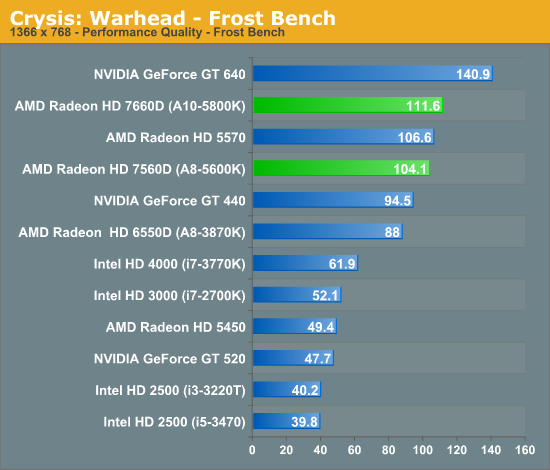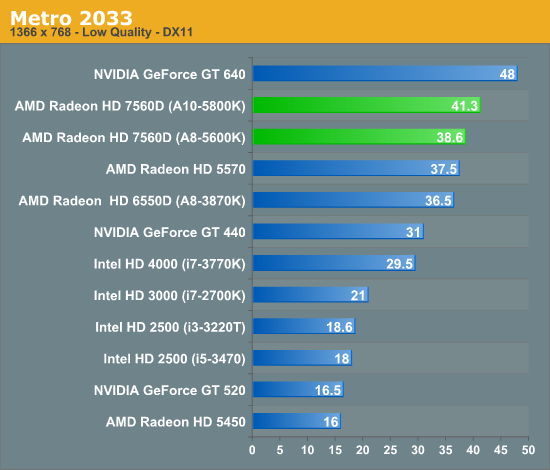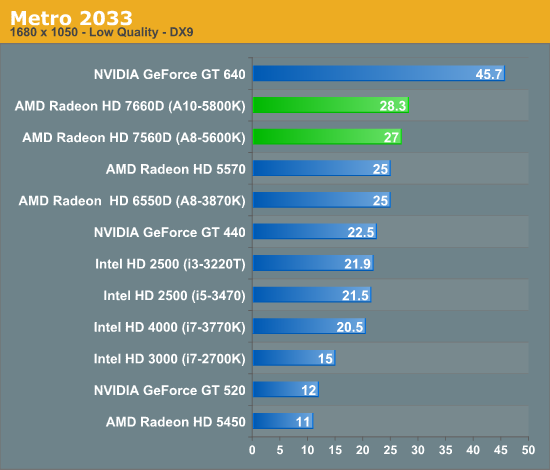AMD A10-5800K & A8-5600K Review: Trinity on the Desktop, Part 1
by Anand Lal Shimpi on September 27, 2012 12:00 AM ESTCrysis: Warhead
Our first graphics test is Crysis: Warhead, which in spite of its relatively high system requirements is the oldest game in our test suite. Crysis was the first game to really make use of DX10, and set a very high bar for modern games that still hasn't been completely cleared. And while its age means it's not heavily played these days, it's a great reference for how far GPU performance has come since 2008. For an iGPU to even run Crysis at a playable framerate is a significant accomplishment, and even more so if it can do so at better than performance (low) quality settings.



Crysis sets the tone for a lot of what we'll see in this performance review. The Radeon HD 7660D on AMD's A10-5800K boosts performance by around 15 - 26% over the top end Llano part. The smaller, Radeon HD 7560D GPU manages a small increase over the top-end Llano at worst, and at best pulls ahead by 18%.
Compared to Ivy Bridge, well, there's no comparison. Trinity is significantly faster than Intel's HD 4000, and compared to HD 2500 the advantage is tremendous.
Metro 2033
Our next graphics test is Metro 2033, another graphically challenging game. Like Crysis this is a game that is traditionally unplayable on many integrated GPUs, even in DX9 mode.



Metro 2033 shows us a 6 - 13% performance advantage for the top end Trinity part compared to Llano. The advantage over Intel's HD 4000 ranges from 20 - 40% depending on the resolution/quality settings. In general AMD is able to either deliver the same performance at much better quality or better performance at the same quality as Ivy Bridge.
The more important comparison is looking at the A8-5600K vs. Intel's HD 4000 and 2500. AMD is still able to hold onto a significant advantage there, even with its core-reduced GPU.










139 Comments
View All Comments
kyuu - Friday, September 28, 2012 - link
"What I'm most looking forward to is a tablet of Surface quality with a low-voltage Trinity powering it."I should have said Trinity or, even better, one of its successors.
calzahe - Friday, September 28, 2012 - link
Memory is quite cheap now, you can find good DDR3 2133MHz 4GB 2x2GB modules for around 40usd for current 2 channel memory APUs, so you'll need to add just 40usd for another 4GB 2x2GB modules for the 4 channel memory APUs, but if done properly these APUs will be able to use 8GB of Memory. It means that for extra 40USD the new APU would be able to use 8GB of memory what is much more than 3-4GB in current monster video cards which cost 500-600usd. Also for around 100-150usd you can get DDR3 2133MHz 16GB 4x4GB.Can you imagine the level of next-gen graphics if APUs will be able to fully utilise 8GB, 16GB or even 32GB of 4 channel system memory!!!
Marburg U - Thursday, September 27, 2012 - link
So, Anand, you've just called this a "Review".Yes, you named it "part 1", but the fact is that at the moment you are publishing a review with only what AMD HAS TOLD YOU you are allowed to publish and which they are pleased to read.
How the hell can i trust this site's reviews anymore?
silverblue - Thursday, September 27, 2012 - link
You could always go to TechReport and join in the AMD bashing if you prefer. Whilst I don't completely agree with the idea of partially lifting the NDA in a specific fashion, it's clear that AMD wants to highlight the strengths of Trinity without possibly clouding the waters with middling x86 performance.Piledriver is not AMD's answer to Intel, even Vishera won't be an i7 competitor in most things and might struggle to stay with the i5s sometimes, and Zambezi was definitely underwhelming as a whole, so I can understand why they wouldn't want to focus on CPU performance. Additionally, if Vishera is due out at the same time as Trinity and you get an early idea of Trinity's CPU performance, even though Vishera will be generally faster than Trinity it may be classed at the same performance level.
cmdrdredd - Thursday, September 27, 2012 - link
What's clear is AMD cannot compete in benchmarks that matter to most people who read these sites(how fast does it transcode my video vs an i5). So they try to hide that behind GPU performance charts.It's like Apple misleading people about the performance of their CPUs back in the day.
silverblue - Thursday, September 27, 2012 - link
Amusingly, you'd think it would easily beat an i5 at transcoding... :PTaft12 - Sunday, September 30, 2012 - link
Uhh the benchmarks the readers of this site care about are the ones that ARE here - the gaming benchmarks. AT readers are intelligent enough to know CPUmark, Sandra, etc mean less than nothing.torp - Thursday, September 27, 2012 - link
The A10 65W looks like it has the same GPU and about 10% less CPU clock. Now THAT part could be really interesting for a low cost PC...rarson - Thursday, September 27, 2012 - link
Crossfire? Pairing one of these with a mid-range card in a hybrid Crossfire setup would be pretty awesome in an HTPC setup. Almost like a next-gen console, but much better.RU482 - Thursday, September 27, 2012 - link
looking to upgrade a couple of lower power SSF systems with one of those 65W CPUs. wonder how much an ITX mobo will run